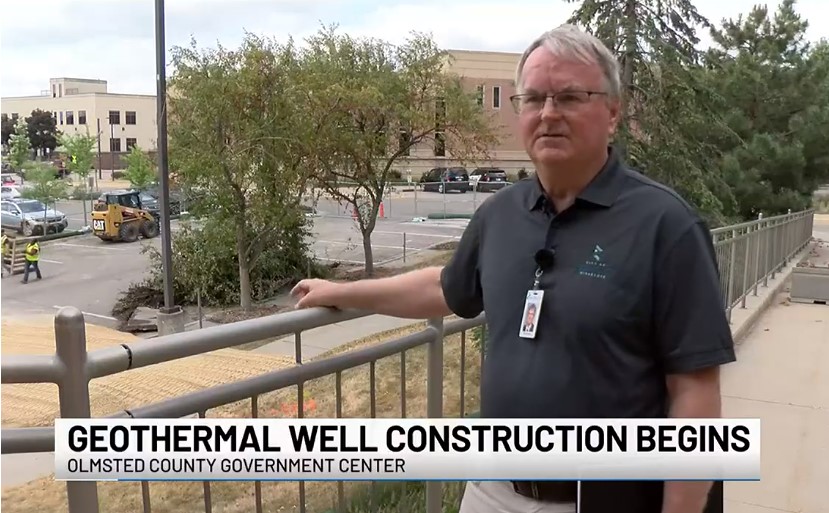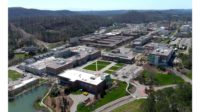Rochester, Minnesota, is a city that epitomizes a blend of progress, innovation, and pride in their community. This vibrant city has evolved in monumental ways in recent years, transforming itself into a hub of cutting-edge healthcare and technology.
Known for its rich history and pride in being home to the renowned Mayo Clinic, it comes as no surprise to find out just how passionate and invested Rochester is in reaching the remarkable goal of reducing greenhouse gas emissions 50% by 2030 and by 100 percent by 2050. Rochester Public Utilities, the City’s electrical service provider, has set a goal of providing 100% renewable electrical energy by 2030.
The Rochester City Council, Mayor, City leaders, and staff have created a vision and authorized planning to meet these bold and daunting goals, fearlessly guiding Rochester toward becoming an undeniably unrivaled standard of excellence. Alongside many other sustainable and renewable efforts, Rochester has chosen to utilize the power of geothermal energy, specifically Thermal Energy Networks, also known as TENs, to achieve their goal of reducing carbon emissions, and they have already begun the process of designing, drilling, constructing, and installing systems.
So, how does all of this work? You may be wondering what geothermal energy is meant to do, or perhaps you’re curious as to what a TEN is and how it can impact carbon emissions so dramatically. There’s a lot to learn, but it’s a very simple concept, so let’s dive in to learn how Rochester is designing ambient TEN to become a beacon of sustainability and progress.

HOW DOES IT ALL WORK?: Scot Ramsey, the manager of Facilities and Properties for the City of Rochester, states that education is key to understanding the new series of complex systems that will help the city meet its energy goals. (Courtesy of Scot Ramsey)
An ambient loop thermal energy network, also known as a low-temperature district energy system or ambient temperature loop, is a type of thermal energy distribution system that operates at lower temperature differentials compared to traditional district heating systems. Here are some advantages associated with ambient loop thermal energy networks:
-
Lower Heat Losses:
- Ambient loop systems operate at lower temperature differentials, which reduces heat losses during the distribution of thermal energy. This can result in higher overall system efficiency and lower energy consumption.
-
Enhanced Efficiency with Low-Temperature Sources:
- Ambient loop networks are well-suited for utilizing low-temperature heat sources such as waste heat from industrial processes, solar thermal collectors, or geothermal energy. This allows for the efficient utilization of diverse and renewable energy sources.
-
Flexible Heat Sources:
- The lower operating temperatures of ambient loop systems make them compatible with a variety of heat sources, including renewable energy and waste heat recovery. This flexibility supports the integration of environmentally friendly and sustainable energy sources into the network.
-
Reduced Infrastructure Costs:
- Lower operating temperatures may allow for the use of less expensive materials in the construction of the distribution network. Additionally, lower heat losses mean that less insulation is needed for pipes, contributing to potential cost savings in infrastructure development.
-
Energy Storage Compatibility:
- Ambient loop systems can be integrated with thermal energy storage technologies, allowing for the storage of excess thermal energy during periods of low demand. This enhances system flexibility and helps to meet variable energy demand effectively.
-
Lower Environmental Impact:
- By utilizing lower-temperature heat sources and minimizing heat losses, ambient loop thermal energy networks can contribute to a lower environmental impact compared to traditional district heating systems. This aligns with sustainability goals and reduces greenhouse gas emissions.
-
Improved Efficiency:
- Ambient loop systems can be designed to operate efficiently in both heating and cooling modes, making them suitable for regions with varying climate conditions. This flexibility enhances the overall efficiency of the system.
-
Less Energy Intensive Distribution:
- Lower operating temperatures result in reduced energy requirements for pumping and distributing thermal energy through the network. This can lead to lower energy consumption and operational costs.
-
Integration with Existing Infrastructure:
- In some cases, ambient loop systems can be integrated with existing heating and cooling infrastructure, providing a cost-effective way to upgrade and modernize traditional district energy systems.
-
Support for Decentralized Energy Generation:
- Ambient loop networks can support the integration of decentralized energy generation sources, such as on-site renewable energy systems or combined heat and power (CHP) units, fostering a more distributed and resilient energy infrastructure.
While ambient loop thermal energy networks offer several advantages, the specific benefits can vary depending on the local conditions, available heat sources, and the overall design of the system. These systems contribute to the overall goals of energy efficiency, sustainability, and the transition to cleaner and more resilient energy solutions.
The city, utility, and the customer want to use less primary energy, reduce costs, and decarbonize. That is the point of converting society’s heating and cooling systems to sustainable, networked resources. The key is the water-energy relationship. Water can absorb, store, and transfer a significant amount of thermal energy. This water-energy relationship is critical for sustainable development and has implications for both the water and energy sectors. Current systems have wasted energy — 80-90% of energy used to heat hot water is wasted as it flows down the drain. Cooling during heating system rejects energy to the atmosphere. Thermally connected buildings can exchange waste energy. Cities have recoverable thermal energy in potable water, sewer, storm, and other dewatering systems. Technology exists that can safely and economically utilize this energy under the streets.
When a large metro neighborhood is being considered for a thermal energy network, an analysis will be conducted to identify common wastewater drainage configurations, proximities to dewatering operations, thermal profiles from neighboring building owners, surface water, water utilities, etc. Before considering any costly geothermal holes in the ground, the aggregation of demand and summarized load-sharing potential across shared resources will be evaluated. Unmet loads can then be matched by geo-exchange or heat transfer through fluid volumes across large thermal networks themselves.
Building heating and cooling demands are also as diverse as the sources and sinks themselves. The most efficient system matches the supply with demand. Old steam networks typically supply a high-grade energy source of more than 212°F. That supply is typical serving a low-grade energy demand within the buildings. To maximize efficiency, new thermal energy networks must strive to match the supply and demand energy qualities, lower building heating water temperatures (180°F to 130°F), and increase end-use efficiencies (demand management).
While many structures do not have much load diversity to promote energy sharing, they could each leverage the effluent drains to provide domestic hot water (DHW). This process is also called wastewater energy transfer (WET). A WET system for structures of the size found in residential urban areas will require an energy system with thermal energy storage (TES). Assuming that the DHW demand is entirely met by each building’s unique WET, the geo-exchange system is free to operate at much lower temperatures and loads for space conditioning purposes only. Working closely with future neighborhood building designers, it may be possible to further reduce these heating and cooling supply temperatures through radiant hydronic, such as tubes installed in the subfloors or even chilled beams. Thermally connected developments can collocate complimentary diverse heating and cooling load profiles to maximize thermal system efficiency (i.e. data centers, pools, skating rinks, grocery stores, healthcare facilities, etc.).
Communication and education of the Thermal Energy Networks value proposition to developers is critical. Staffing to maintain TENs is an issue to be addressed. Cities and TENs operators will need to address acceptable risk and have a long-term perspective to meet decarbonization goals.
Key elements or platform for the proposed Thermal Energy Networks in Rochester MN:
- Renewable electric power and integrated with TEN
- Heat pumps and solar thermal panels
- Ambient thermal energy transportation loops connected to building heat pumps
- Ambient thermal energy transportation loops connecting dense urban buildings to open areas with various geothermal assets
- Buildings converted to use low temp water (<130°F)
- Optimize building efficiency (demand side management)
- Interconnected AI thermal systems. Data smart systems
- Identify all connectable thermal sources and sinks to reduce drilling requirements and, therefore capital costs
- Match the energy grade of the demand to the energy grade of supply options
- Integrate the TEN so it is scalable and opportunistic with other street and project work. Connects resources in functional stages over each construction season
- City-wide TEN scope (commercial, industrial, and residential) to achieve city goals
Potential Source / Sink for transportation loop serving heat pumps:
- 5th generation district heating and cooling (5GDHC) – two pipe ambient transportation loop
- Geothermal wells –Closed loop aquifer heat exchangers and closed loop vertical/horizontal direct boreholes, doublets (extraction/injection)
- Sewer energy recovery or waste energy transfer (WET)
- Potable water
- Surface water – lake/river closed loop
- Air
- Solar thermal
- Doublets – extraction and reinjection closed loop from the aquifer. Aquifer thermal energy storage (ATES)
- Energy piles
- Thermal capacity available within usable site boundaries and with transportation loop to remote locations off-site
- Building use types and estimated thermal loads and energy models to understand simultaneous heating and cooling for sharing waste energy
The choice of source and sink depends on factors such as climate, available space, geological conditions, and local regulations. Hybrid systems that combine different sources and sinks can optimize efficiency across various conditions.
Concepts:
- Thermal energy networks — decentralized, bi-directional, ambient, recycled waste heat-simultaneous heating and cooling.
- Thermal energy networks are based on the exchange of thermal energy between buildings with different needs. The principal grid carries a low-temperature flow to active and distributed substations which upgrade the temperature to the required level. Prosumers produce and consume energy.
- Low-temperature TEN transportation loop positions the city to adapt and implement new technology when available. Attempt to future-proof investment, manage energy cost, and mitigation of long-term risk.
- Low temp (130°F) hot water building to match heat pump temperature.
- Integrating TEN, sewer/water/electric utility-water-energy nexus. Operating and designed as a system not just discreet entities operating independently. New paradigm for cities.
- Thermal storage — ambient loop, potable, and sewer? Off-peak, time of day, impact on electrical utility?
- Economic, social, and environmental benefits. Intangibles of decarbonized buildings.
City of Rochester’s Next Steps:
- Energy mapping of potential TEN locations.
- Develop residential TEN concept/models.
- Develop a financial model with assumptions on operating model and policies.
- Economic analysis, including estimated capital investment and operating costs.
- Operating model, strategies, policies, development plan.
- Value proposition for developers, owners, City, etc.
- Final City approval of TENs.
Quote from Jay Egg with Egg Geo: As Rochester continues to evolve, it stands as a testament to human innovation, resilience, and the power of collective vision. Its story is one of transformation, progress, and unwavering dedication to shaping a future that honors its past while embracing the endless possibilities of tomorrow. Rochester, Minnesota, epitomizes the essence of a thriving modern city — a place where tradition meets innovation and bold efforts are realized and executed with pride. What’s happening in Rochester is beyond impressive. The results of this groundbreaking project will be the standard for future communities that are striving to become renewable and sustainable as well, and Rochester will be responsible and credited for building momentum that will catch on and spread like wildfire to other parts of the world.
Rochester would like to share the path forward with interested parties nationwide. Geothermal Rising is organizing the inaugural Thermal Energy Network Symposium, which will be taking place March 12-14, 2024, in Rochester, Minnesota, at the Mayo Civic Center. For more information and to register, go to the following link(s): https://bit.ly/3RDe16P
The Destination Medical Center in Rochester - Sustainability Series shows how the city is moving forward with Thermal Energy Networks: https://youtu.be/DIHLREw-drs and below.





Report Abusive Comment